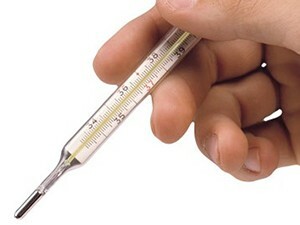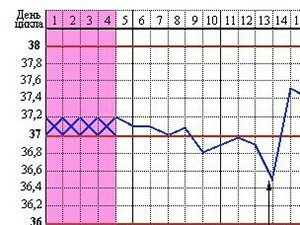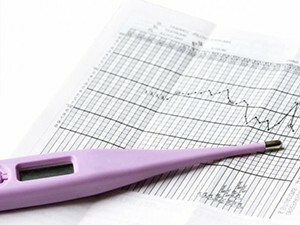Age changes in the reproductive system begin almost imperceptibly. But they can lead to not very good consequences, both in terms of well-being and health prospects. There is an additional need to control them. One of the characteristic indicators contributing to this is the basal temperature in menopause, the schedule of which differs from that observed before the onset of ovarian failure.
More about BT value
 The basal temperature is dependent on the condition of the reproductive system. The values of the indicator reflect any changes occurring in it: the stage of the menstrual cycle, pregnancy, illness. And although additional research is needed to determine their causes, it can prompt the presence of any trouble.
The basal temperature is dependent on the condition of the reproductive system. The values of the indicator reflect any changes occurring in it: the stage of the menstrual cycle, pregnancy, illness. And although additional research is needed to determine their causes, it can prompt the presence of any trouble.
For accurate information, BT measurements must be regular. It is not enough to know its meaning only for a month. This also applies to the reproductive period. But when the basal temperature is necessary for menopause, doctors insist that the schedule makes sense to lead for a long time. Including the indicators for the days of the cycle, it will show the increase-decrease, the difference from normal values or compliance with them.
How does BT change with the arrival of menopause
In the reproductive age, the basal temperature is needed to detect:
- of the Day of Aging of the Egg;
- Definitions of the phase of the cycle;
- Pathologies in the reproductive organs.
All of the above depends on the functioning of the gonads. Going to the period of menopause, they slow down their work, the level of hormones they produce begins to fluctuate. This is reflected in the basal temperature, they lose their previous regularity.
Previously, the change in activity and high amounts at different stages of estrogens and progestins led to the fact that:
- In the initial phase of the cycle, 36.2-36.6 degrees was observed;
- In the second period of the menstrual period from 36.7 to 37;
- Before ovulation, there was a jump to 36.7-37.2.
Now in connection with the decrease in the volume of sex hormones BT:
- In premenopause fluctuates with their concentration;
- No apparent changes in the middle of the cycle due to lack of ovulation;
- Acquires monotony after menopause and in a later period.

It is important that now in the premenopausal stage it is impossible to use the BT schedule in calculating the days that are safe for conception, since it is impossible to detect them. In this phase of the body's development, ovulation is still possible, but unpredictable.
Why BT should be measured after the end of menstrual function
 A woman who approaches the age of menopause hardly plans to get pregnant again .And it is impossible to protect yourself by identifying this indicator, since the probability of an error in determining safe days is high. So what is the measurement of BT in menopause?
A woman who approaches the age of menopause hardly plans to get pregnant again .And it is impossible to protect yourself by identifying this indicator, since the probability of an error in determining safe days is high. So what is the measurement of BT in menopause?
This age is in some ways critical. That is, it is fraught with the emergence of many diseases of the reproductive sphere, endocrine, tumor. Inconsistency of basal temperature to normal values will help
- Identify the very approach to menopause. If the monthly ones come less often, the age is about 45 years, the state of health has changed, additional measurements of BT will help to establish the beginning of fading in the function of the ovaries. Since the premenopause can last for years, it will give an opportunity to control its course;
- Learn about the negative changes that have occurred in the reproductive organs. Activated in some women, or for the first time the resulting endometriosis, hyperplasia, fibroids, cancer tumors always give rise to BT.Even a simple inflammation due to a cold will affect her schedule by increasing;
- Determine the need for hormone therapy to improve well-being in menopause. Her syndrome can have only a part of the symptoms, for example, only the dryness of the mucous in the intimate area or psychoemotional manifestations, to which not all are given due importance. But if they have high BT values, this indicates a strong effect of these symptoms on the body and the need to eliminate them;
- Set the body's response to hormone therapy. Not everyone to whom it is shown and used, tolerates these drugs well. When they are taken, accompanied by increased BT, you may have to adjust the dosage or choose another means.
When it is important to know the climacteric BT
, Climax increases the likelihood of diseases for all. But especially thoroughly and for a long time the basal temperature at menopause should be controlled by those who:
- In the family history there are oncological diseases of the reproductive organs or mammary glands;
- At a young age, there were heavy births, abortions, and other surgical interventions in the genital area;
- There were no pregnancies, childbirth, lactation;
- There are chronic inflammatory diseases of the reproductive organs;
- Disturb severe menopause;
- There are bleeding for unexplained reasons.
If the rate is rejected from the normal rate, this is an absolute reason for visiting a specialist.
 We recommend to read an article about how menopause begins in women. You will learn about the causes of its onset, the manifestations of menopause, ways of alleviating severe symptoms.
We recommend to read an article about how menopause begins in women. You will learn about the causes of its onset, the manifestations of menopause, ways of alleviating severe symptoms.
How to measure BT
 The indicator is subject to the slightest third-party influence, so to obtain correct results it is important to perform the algorithm:
The indicator is subject to the slightest third-party influence, so to obtain correct results it is important to perform the algorithm:
- Sexual, emotional and physical rest 4-6 hours before measurement;
- Manipulation at the same time every day, best in the morning;
- Use of the same thermometer.
Some women seem to think that basal temperature does not matter with menopause, the schedule is too tiring. But if you adjust to measuring it regularly, it will not be so difficult, and most importantly, you can avoid much more serious problems.
Reproductive system - a delicate tool, it is not easy to identify a malfunction in it. A control over BT will help to find out about them at an early stage of a possible disease.
